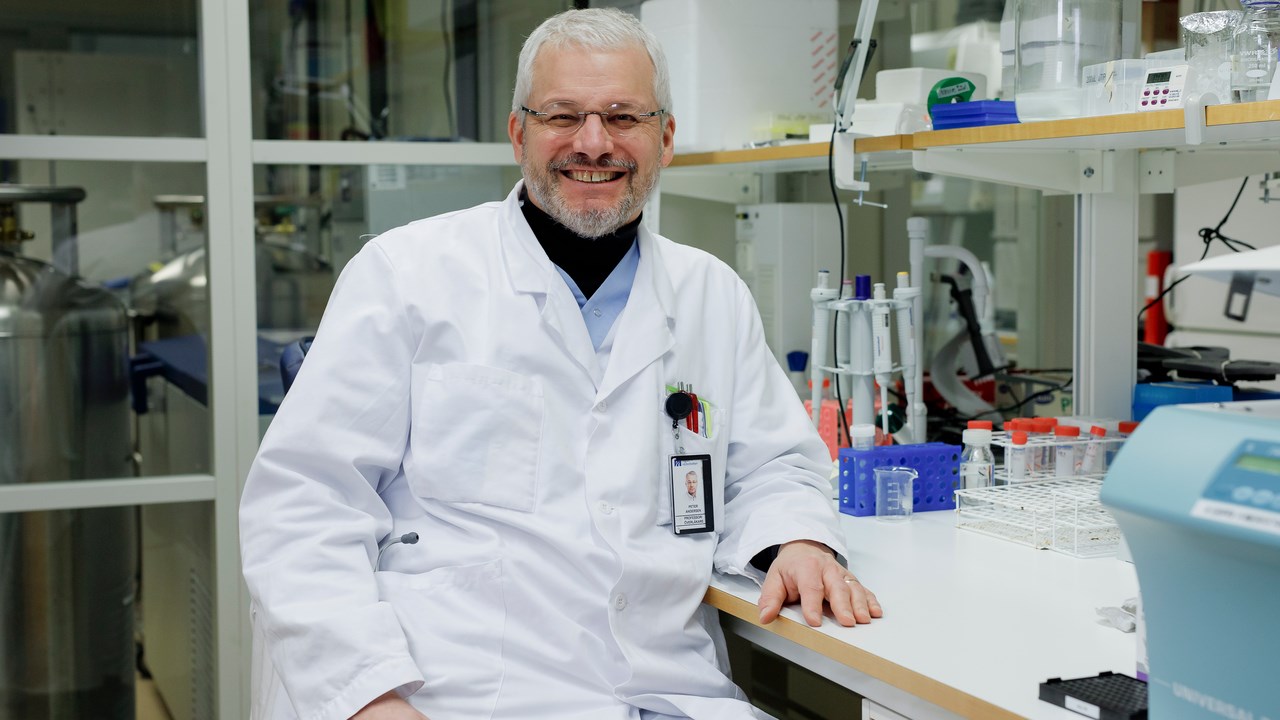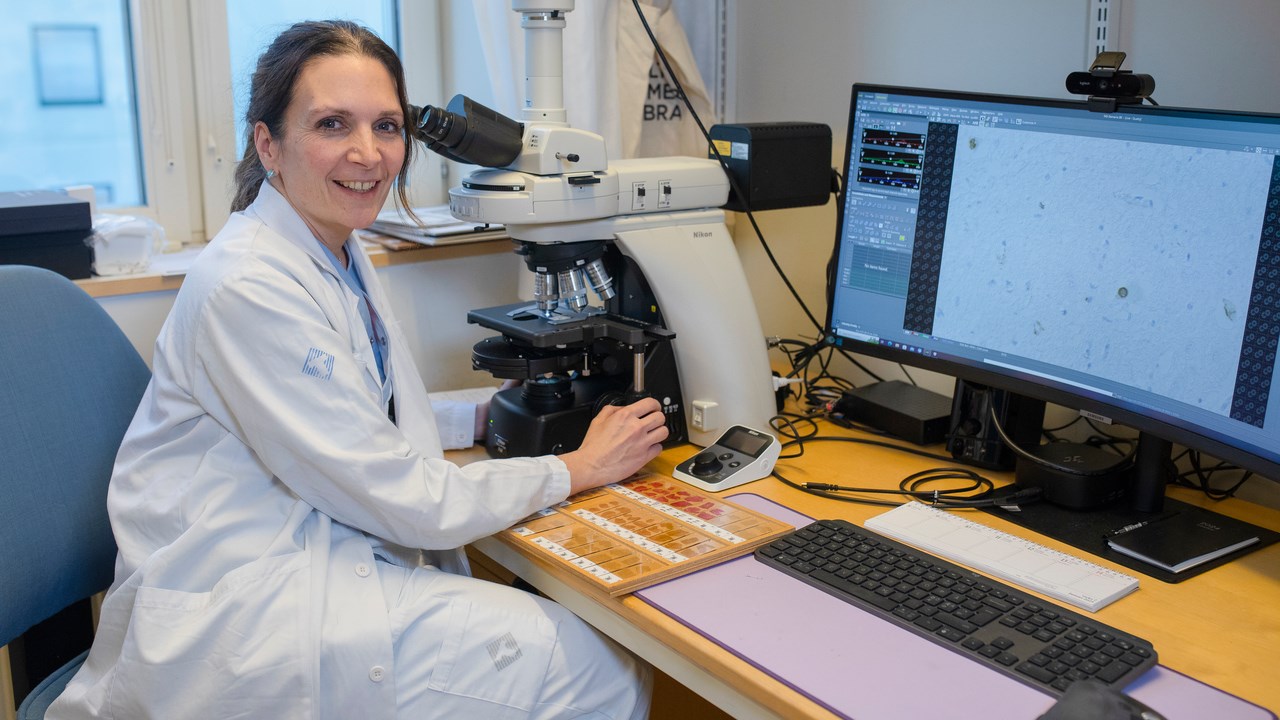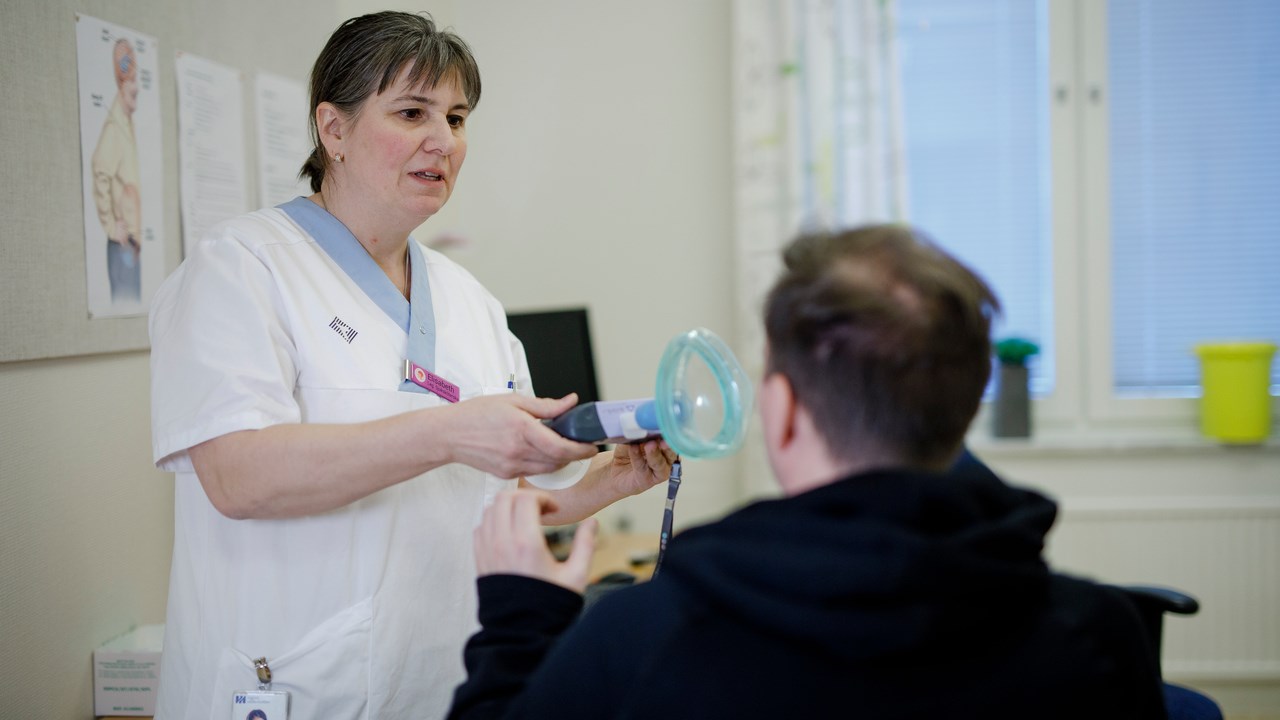NEWS There has been a breakthrough in the research on the disease amyotrophic lateral sclerosis (ALS). Scientists at Umeå University report that the disease progression in a patient with a particularly aggressive form of ALS disease has slowed down considerably with the use of a new gene therapy. After four years on the medication, the patient can still climb stairs, rise from his chair, eat and speak well, and live an active and socially forfilling life.
–I consider this a breakthrough for the research we have conducted for more than 30 years, here at Umeå University and University Hospital of Northern Sweden. We have never before seen treatment results as effective as these, using any other treatment, says Peter Andersen, a neurologist and professor at the Department of Clinical Sciences at Umeå University.

Peter Andersen, professor at the Department of Clinical Sciences, Neuroscience unit, and senior staff consultant neurologist at University Hospital of Northern Sweden.
ImageMattias Pettersson
– An important discovery is that it is now possible to considerably reduce the levels of the disease-causing SOD1 protein, and simultaneously measure a clear inhibitory effect on further disease progression. When we diagnosed the patient at the neurology ward in early spring 2020, the patient’s prognosis was 1,5–2 years of survival at best. The patient has far, far exceeded expectation.
The patient is from a family in southern Sweden with a particularly aggressive form of ALS disease caused by a mutation in the SOD1 gene. When a relative was diagnosed with ALS, the patient left a blood sample for research purposes to the ALS research team at Umeå University but chose to not learn about the results of the genetic test. However, the patient was a carrier of the disease gene, and after experiencing muscle weakness four years ago, the patient realised that he too was afflicted. The patient was immediately received by the medical team at University Hospital of Northern Sweden and was diagnosed with early stage ALS disease.
Since the summer of 2020, the patient is a participant in the phase 3-study sponsored by the pharmaceutical company Biogen evaluating a new gene therapy developed for patients with SOD1 mutations causing misfolding and aggreggation of SOD1 protein in motorneurons. Every four weeks, the patient has been receiving the experimental treatment at a university hospital in Copenhagen in Denmark.
At the time of diagnosis in 2020, the patient’s levels of the substance neurofilament L – a biomarker indicating breakdown of nerve cells – was very high. Now, four years later, the levels are reduced by almost 90 percent.
– When the patient was diagnosed at University Hospital of Northern Sweden in April 2020, we measured the level of neurofilament L to be as high as 11,000 nanograms per litre, which is high even for an ALS patient. In the most recent sample, after 50 injections of the new drug, the level is down to 1,200 to 1,290, which is a substantial decrease of the disease indicator. The normal level for a person in the patient’s age group is below 560. In blood, the level of neurofilament has fallen back to normal levels, and was down to 12 during the latest hospital visit. The normal level is less than 13, says Peter Andersen.
The patient’s level of function, measured using the scale ALSFRSR, is reduced compared to a healthy individual (48 points) but has stayed at almost the same level, around 35 to 37 points, for the last 18 months – that means that the patient’s functional level is reduced by approximately 26 percent compared to a healthy individual.
A person with this aggressive type of ALS gene mutation that the patient has typically loses 1–1,5 points every month. That means that without treatment, the expected disease progression would have been very fast and given rise to substantial disability within 6–12 months, and, most likely, have lead to the patient’s death in 2021.
– That this patient, more or less unimpeded, still can climb stairs four years after disease onset, that is somewhat of a miracle to see, says Karin Forsberg, a neurologist and researcher at the Department of Clinical Sciences who works alongside Peter Andersen and has researched SOD1 and ALS for more than two decades.

Karin Forsberg, neurologist and researcher at the Department of Clinical Sciences.
ImageMattias Pettersson– To have succeeded with a drug treatment in this way is a great success and an inspiration. But it does not in any way mean that the job is done. This is just the beginning. It is also important to remember that the drug in question does not constitute a curative treatment, but it seems able to put the brake on disease progression. It gives us great hope to further develop pharmaceutical treatments for ALS-patients.
There are many types of ALS disease, and only 2 to 6 percent has an ALS disease caused by a mutation in the SOD1 gene. Many have a familial form of the disease, but mutations in SOD1 have also been found in so-called sporadic cases of ALS.
– Whether this drug has a similar effect on other types of ALS disease is currently unknown. There is need for much more research on the subject, says Peter Andersen.
The patient can still do almost all things that he could do when he first joined the study in the summer of 2020 – his speach is unaffected, and he manages to do everything himself, he mows the lawn, goes shopping, and takes care of his children. Mentally he also feels a lot better, mainly because he now dares to feel hope.
The study that the patient is participating in ends this summer. The medication is not yet available in Sweden, but it has been approved by the United States Food and Drug Administration, FDA, and on the 23 of February 2024 the European Medicines Agency, EMA, recommended the use of the drug on patients with SOD1 gene mutations within the European Union.
However, the New Therapies Council i Sweden has asked the regional healthcare providers not to prescribe the drug until a health economic evaluation has been provided by the Dental and Pharmaceutical Benefits Agency.
– Our next step is to study the results from the patients receiving this drug. It has worked for some, but not all have seen the same positive effect. It could be a question of dosage, or at which disease stage the treatment was initiated. Maybe additional drugs are required to completely stop the process? Those are questions we now have to try and answer. This is only the beginning, says Karin Forsberg.
She pictures a future where treatment will be given based on what type of ALS disease the patient has, and that it most likely will require a combination of drugs. She emphasises that there is much research being conducted both in Sweden and internationally to find new drug targets so that equivalent drugs can be developed for patient groups with other types of ALS, and she is hopeful that it will come true.

Research nurse Elisabeth Müller Granberg will use a spirometer to test the ALS patient's respiratory capacity.
ImageMattias Pettersson– We can measure in samples collected from the patient that the disease process is ongoing, but the patient’s body seems able to compensate. Even now, four years after the patient started taking this new gene therapy drug. The Swedish Ethical Review Authority approved participation in these studies and now, several years later, we, as well as ALS physicians in other participating countries, see a clear clinical effect on many treated patients, says Peter Andersen.
– The next step will be to get approval from the Swedish Ethical Review Authority to study the compensatory mechanisms that treatment with this drug seems to have activated. There might be an opportunity here to get insights into how previously unknown parts of the nervous system work, and to develop even better new drugs.
Peter Andersen, chief neurologist and professor at the Department of Clinical Sciences, talks about the study, and the ALS patient is seen performing tests at University Hospital of Northern Sweden.
Find out more and watch a longer version of the inteview with Peter Andersen and Karin Forsberg at the ALS Research Umeå webpage.
The patient in question has left written consent to participation in this publication. The family has expressed a strong wish to have their privacy respected. Other family members have died in ALS (none participated in the study). Other patients, who participated in earlier tofersen studies and were given either a lower dose or placebo, have died. The decision to make this public was taken independently of the pharmaceutical company Biogen.
Background information
There are many types of ALS disease – some are caused by a hereditary gene mutation, so-called familial ALS, but the cause is unknown in most cases.
Approximately 2 to 6 percent of all ALS patients have a hereditary mutation in the SOD1 gene encoding the protein by the same name. SOD1 protein is found in all cells of the body, and its normal function is to neutralise free radicals, a so-called antioxidant.
The pharmaceutical drug in the phase 3-study VALOR is tofersen, or Qalsody (Biogen). It is an antisense oligonucleotide (ASO) that causes breakdown of the mRNA formed when the gene encoding the enzyme SOD1 is read. The result is that the synthesis of new SOD1 protein is reduced. This means that the drug inhibits the formation SOD1.
Tofersen has only been tested on patients with SOD1 gene mutations and not on patients with any other form of ALS disease.
During the first six months of the VALOR study, the participating patients received either tofersen or a placebo. After that, the patients continued in the open label extension (OLE) of the study where all were given the active drug, i.e., tofersen. The OLE-part of VALOR is soon ending. In an earlier phase 2-study – also with participation of Swedish patients – tofersen was given in different dosages (20, 40, 60 or 100 milligrams) and the highest dose was determined to be the best one.
The drug is administered by injection in the spinal fluid and requires lumbar punction, which has caused the patient some minor headaches and back pain in connection to receiving the drug. Other than that, the patient has experienced few side effects and feels that his disease is more stable since beginning treatment.
The drug study has been performed in several countries and the equally promising results as for the Swedish patient has been reported by researchers in Germany, Belgium, USA and Canada, among others. Those evaluations have been made independently of the pharmaceutical company that has developed the drug.
The promising results seen in patients with SOD1 ALS disease has inspired the ATLAS-study, where early treatment with tofersen in healthy carriers of the SOD1 mutation is evaluated. The ATLAS-study started in 2021 and is still ongoing.
If you have questions: Send an e-mail to ALSforsk@umu.se or read more at the ALS Research Umeå webpage.
Potential conflicts of interest
Karin Forsberg is a specialist neurologist at the neurology clinic, University hospital of Northern Sweden, and researcher at the Department of Clinical Sciences, Neurosciences unit, at the Medical Faculty at Umeå University. She is the main and co-investigator in pharmaceutical trials sponsored by Amylyx, Biogen, Ionis Pharmaceuticals, PTC-Pharmaceuticals, Sanofi and ITB-Med.
Peter Andersen is a Wallenberg Clinical Scholar, chief neurologist at the neurology clinic, University hospital of Northern Sweden, and professor at the Department of Clinical Sciences, Neurosciences unit, at the Medical Faculty at Umeå University. He is the main investigator for the pharmaceutical trials VALOR and ATLAS sponsored by Biogen, and has since 2014 received fees from participation in advisory committees. The fees have been payed either to his employer Umeå University or him as a private citizen. He is also the main investigator for several other ALS pharmaceutical trial sponsored by competitors of Biogen. He is also a payed advisor to the European Medicines Agency, EMA.